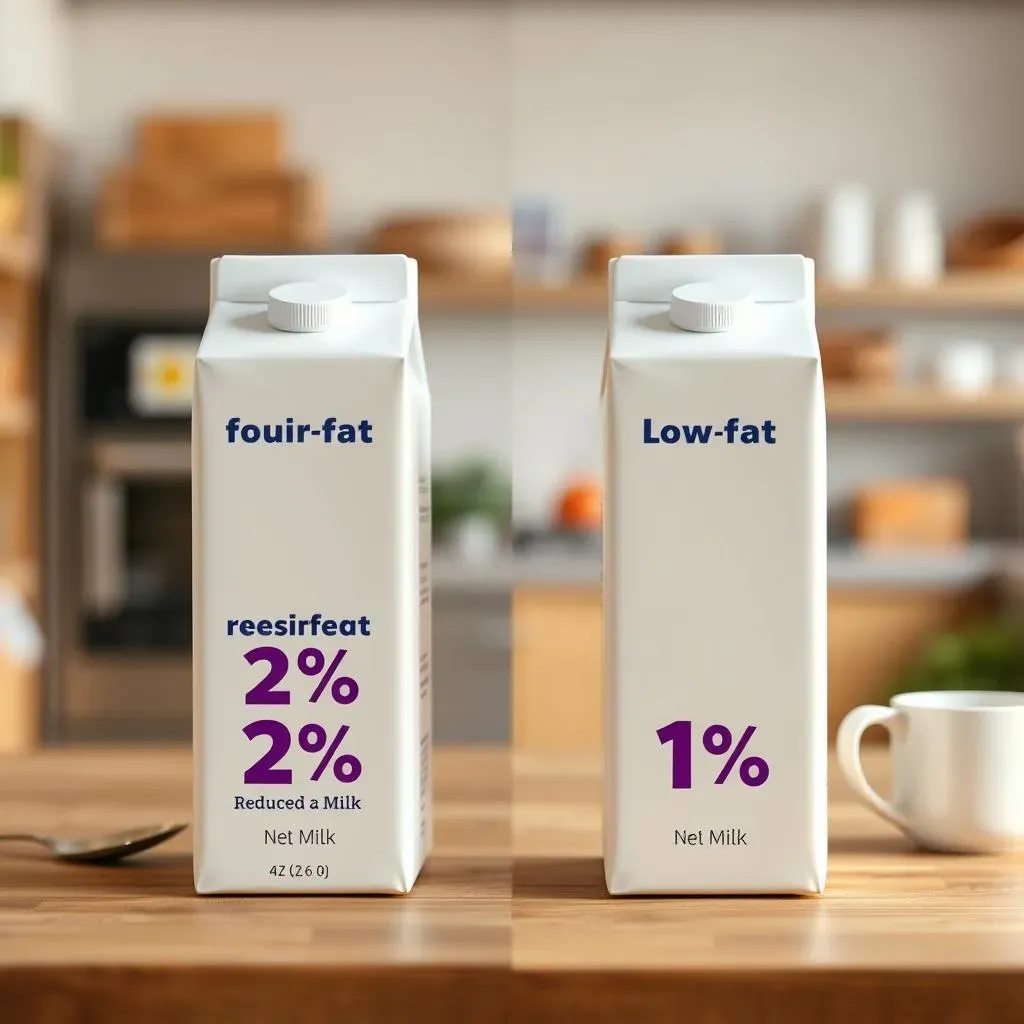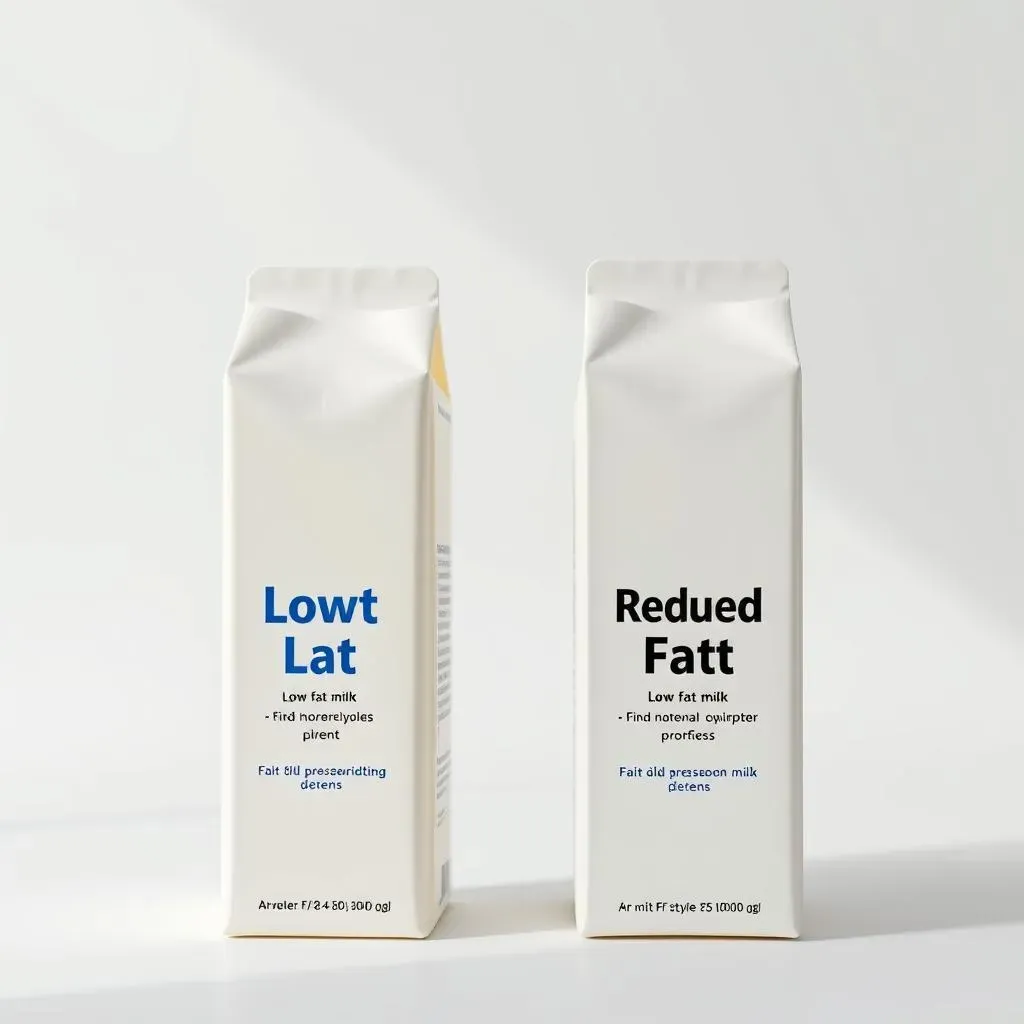Table of Contents
Ever stood in the dairy aisle, staring at the milk options, feeling utterly confused? You're not alone! The labels "low fat" and "reduced fat" can seem like they're playing a game of nutritional hide-and-seek. Is there really a big difference, or is it just marketing magic? This article will cut through the confusion and give you the lowdown on low fat milk vs reduced fat milk. We'll explore what those percentages actually mean, how they impact the taste and nutritional value, and help you decide which carton is the right fit for your lifestyle. Get ready to ditch the dairy aisle dilemmas and become a milk master. We will be covering the specific differences in fat content, how they're processed and how this affects the nutritional profile. By the end of this, you'll know exactly what you're pouring into your glass, no more guessing!
Understanding Milk Fat Percentages

Understanding Milk Fat Percentages
What Do Those Numbers Mean?
Okay, let's talk milk fat. It's not as complicated as it seems, I promise. When you see "whole milk," that means it's got about 3.5% fat. Think of it as the full package, nothing taken out. Then, we have reduced-fat milk, which usually clocks in at 2% fat. This means some of the fat has been removed, but not all of it. It's a bit like taking a small slice off a cake, you still get most of the cake, just a little less rich. And then there's low-fat milk, often labeled as 1% or even skim, which is practically fat-free, at 0.5% or less. It's like having the cake without the frosting, still good, but a different experience.
These percentages might seem tiny, but they make a difference in taste and texture, and how your body digests the milk. The fat content impacts how creamy the milk feels in your mouth. It also plays a role in how well you absorb certain vitamins. It's all about finding the right balance for your needs and preferences. Consider it like choosing the right type of fuel for your body. The percentage of fat is one of the key factors in that decision-making process.
Type of Milk | Approximate Fat Percentage | Description |
|---|---|---|
Whole Milk | 3.5% | Full fat content, rich taste. |
Reduced-Fat Milk | 2% | Some fat removed, lighter than whole milk. |
Low-Fat Milk | 1% or less | Significantly reduced fat, very light taste. |
How is Milk Fat Content Adjusted?
So, how do they actually change the fat content in milk? It's not like they're using tiny spoons to scoop it out! The process is called separation. Fresh milk goes through a machine called a centrifuge. This machine spins milk at high speeds, separating the heavier fat molecules from the lighter milk. Think of it like a salad spinner, but for milk. The fat rises to the top, and then they can remove some or all of it, depending on what type of milk they want to make. It's a pretty neat trick, actually.
After the fat is separated, the milk is often pasteurized. This is a heat treatment that kills harmful bacteria. It's a crucial step to make sure the milk is safe to drink. After pasteurization, the fat is added back in to create the various types of milk. This process ensures the milk is both safe and has the correct fat content. It also ensures consistent quality and taste every time you buy a carton of milk.
- Separation: Milk is spun to separate fat.
- Pasteurization: Milk is heated to kill bacteria.
- Standardization: Fat is added back to achieve the desired percentage.
Low Fat Milk vs Reduced Fat Milk: Key Differences

Low Fat Milk vs Reduced Fat Milk: Key Differences
Fat Content Showdown
Alright, let's get down to brass tacks. When we talk about low fat milk vs reduced fat milk, the most obvious difference is the fat content. Reduced-fat milk, which is usually labeled as 2%, has a noticeable amount of fat compared to low-fat or 1% milk. Low-fat milk has a much lower fat content, often around 1% or even less. This might not seem like a huge difference, but it affects the flavor and texture. Reduced-fat milk will still have a richer, creamier feel, while low-fat milk is much lighter and can even feel a bit watery to some people. The choice often comes down to your personal preference and how much fat you want in your diet.
It's also worth noting that the fat content affects the calorie count. Fat has more calories per gram than protein or carbohydrates, so the more fat, the more calories. If you're watching your calorie intake, low-fat milk can be a better choice. However, it's also important to consider how the fat content impacts the absorption of certain nutrients. Some vitamins, like A, D, E, and K, are fat-soluble, meaning your body needs fat to absorb them properly. If you're drinking fat-free or very low-fat milk, you might not be absorbing those vitamins as effectively. This is where the "reduced" fat option might be a good middle ground.
Taste and Texture Differences
Beyond the numbers, the fat content significantly changes the taste and texture of the milk. Reduced-fat milk tends to have a more full-bodied, richer flavor that’s quite similar to whole milk, just not as intense. It has that creamy mouthfeel that many people enjoy. Low-fat milk, on the other hand, lacks some of the richness, often tasting lighter and a bit more watery. Some people might find it less satisfying because of this. It’s all about what you’re used to and what you prefer.
Think about it like this: if you’re used to drinking whole milk, switching directly to low-fat milk might feel like a big change. You might miss the creaminess. Reduced-fat milk can be a good transition option, as it provides a similar experience while cutting back on some of the fat. If you’re primarily concerned about fat and calories, low-fat milk is the way to go. If you prefer a richer taste and texture, reduced-fat might be your best bet. It's always a good idea to try both and see which one you like best. Taste is subjective, after all!
Feature | Reduced-Fat Milk (2%) | Low-Fat Milk (1% or less) |
|---|---|---|
Fat Content | Around 2% | 1% or less |
Taste | Richer, Creamier | Lighter, Slightly Watery |
Texture | Full-bodied | Thinner |
Calories | Higher than low-fat | Lower than reduced-fat |
Making the Right Choice: Which Milk Is Best For You?

Making the Right Choice: Which Milk Is Best For You?
Your Dietary Needs and Preferences
Okay, so you've got the lowdown on fat percentages and taste, but how do you choose? It really boils down to your individual needs. If you're actively trying to reduce your fat intake and cut calories, then low-fat milk is the obvious choice. It provides the same essential nutrients as other types of milk, just with less fat. On the other hand, if you enjoy the richer taste and creamy texture, and you're not too worried about the extra calories, reduced-fat milk might be more satisfying. Think of it like picking between a light salad and a heartier pasta dish, both have their place depending on what you're looking for.
There's also the matter of how your body reacts to different levels of fat. Some people find that higher-fat milk can be harder to digest, while others don't notice any difference. It's all about listening to your body and paying attention to how you feel after drinking different types of milk. It also matters what you are eating with your milk. If you are eating a meal that is high in fat, maybe a lower fat milk option is a better choice. Consider your overall diet as well. If you're getting plenty of fat from other sources, a lower-fat option might make more sense. In essence, consider your entire nutritional intake when making your decision about what type of milk to drink.
Considering Your Health Goals
Beyond personal preference, your health goals should play a role in your milk selection. If you're aiming to manage your weight, low-fat milk can be a helpful tool, because it will reduce your calorie intake. It can be a small change that can make a difference over time. However, if you're focused on nutrient absorption, especially fat-soluble vitamins, reduced-fat milk might be a better option, since it has some fat to help with absorption but not as much as whole milk. It’s a balancing act, finding what works best for your body's unique needs.
It's also important to remember that milk isn't the only source of these nutrients. You can get vitamins A, D, E, and K from various foods, so if you choose low-fat milk, just make sure you're getting them from elsewhere. Ultimately, the "best" milk is the one that fits into your lifestyle and helps you achieve your health goals. There's no one-size-fits-all answer. It's about finding the option that you enjoy and that supports your overall well-being. Don't be afraid to experiment a bit and see what feels right for you.
Goal | Recommended Milk Type | Reasoning |
|---|---|---|
Weight Management | Low-Fat Milk | Lower in calories and fat. |
Nutrient Absorption | Reduced-Fat Milk | Contains some fat to aid vitamin absorption. |
Rich Taste Preference | Reduced-Fat Milk | Creamier and more satisfying taste. |
General Health | Both Low-Fat and Reduced-Fat | Both provide essential nutrients; choose based on preference and overall diet. |
